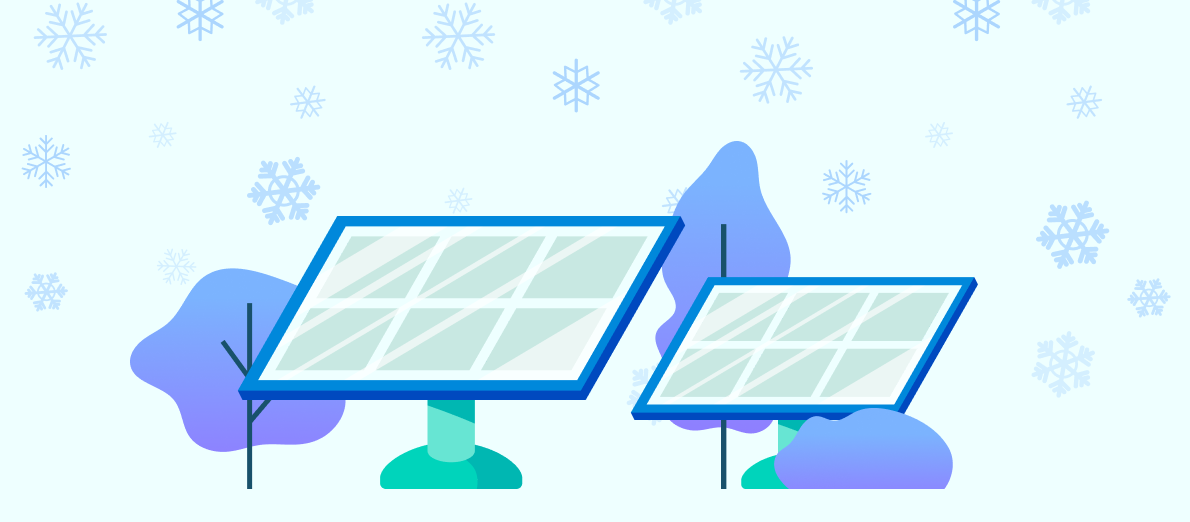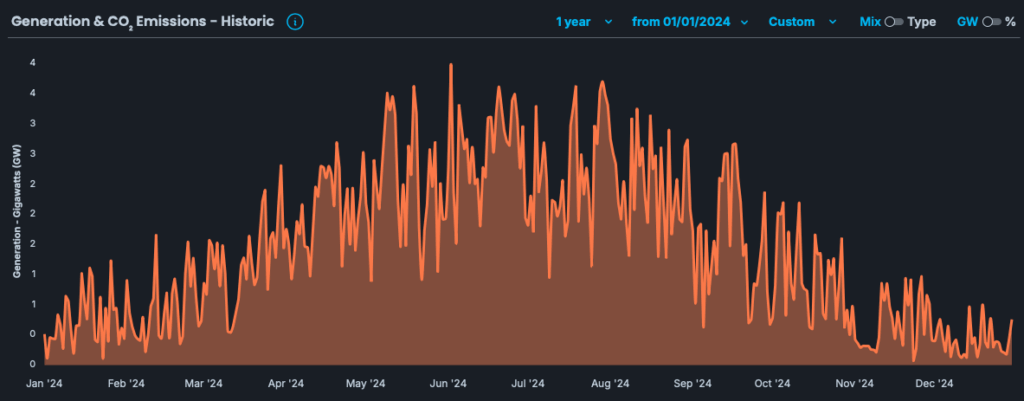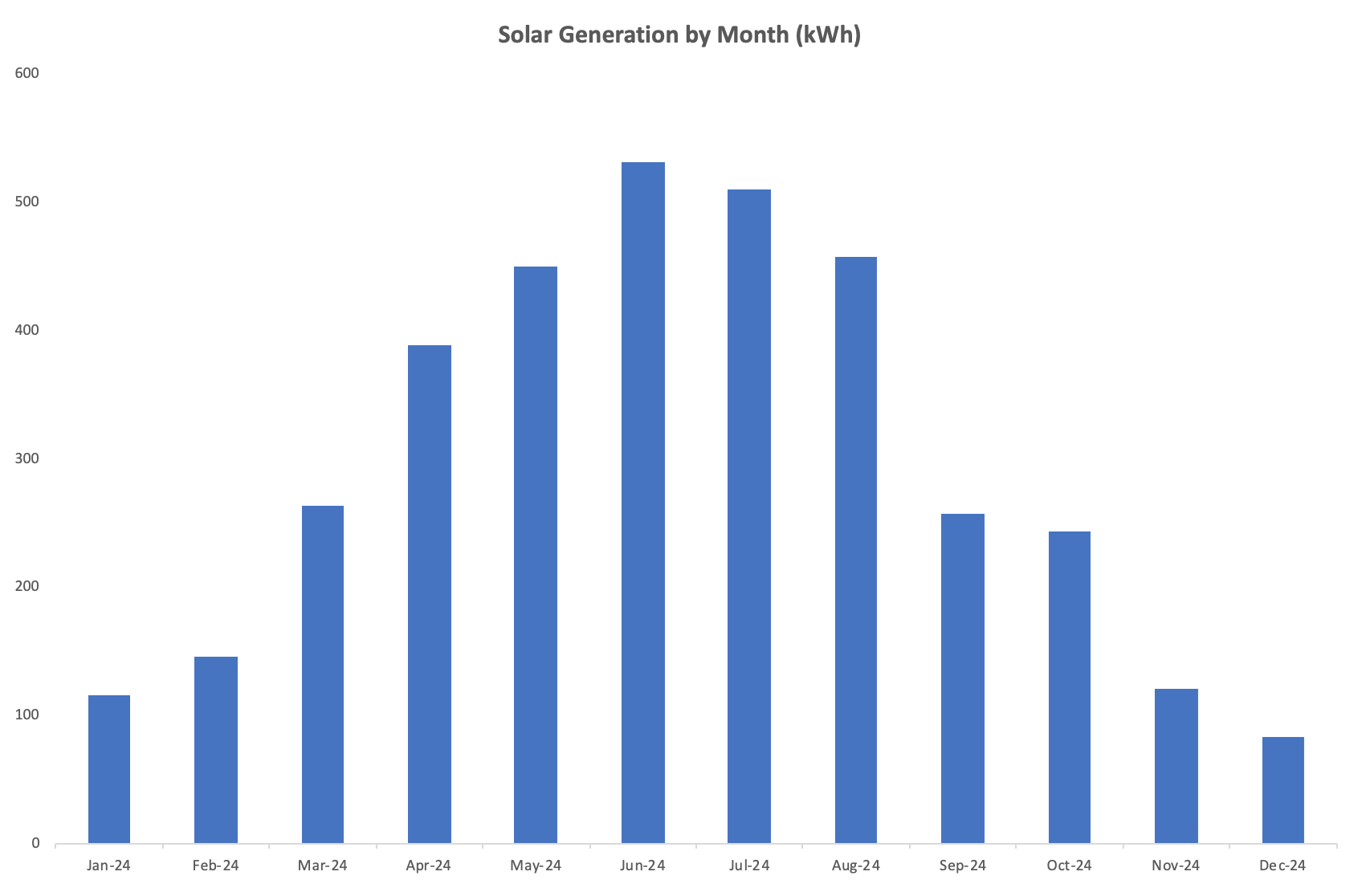0203 193 8888
0203 193 8888

In short, yes! Shorter days and overcast skies might raise doubts, but solar panels work in all seasons – including winter. Remember, solar panels need light, not heat, to generate electricity. Thanks to modern technology and diffused light capture, they continue to provide clean energy throughout the colder winter months.
Let’s look at the data to see how solar generation performs in the UK through the winter months.
Here, we can see the overall solar generation to the UK’s electricity grid through 2024, giving us a good view of how solar generation changes through different times of the year.

Source: Energy Dashboard
Here, we can see the same trend from an individual home set-up:

Source: Energy Stats
With cold temperatures not impacting solar panels, the decline in output is due to the number of daylight hours, the lower angle of the sun and the frequency of cloudy days experienced in the UK winter months compared to summer. The UK averages around 8 hours of daylight in winter compared to 16 hours in summer. That’s 50% fewer hours of daylight, which will immediately result in half the amount of solar production. As we can see above, when you factor this in, with the lower sun and cloudier days, winter output can drop to around 15.0% of that experienced in peak summer months.
Regarding solar panel efficiency, cold weather helps improve panel efficiency by reducing internal resistance. Solar panel output can vary in different temperatures (known as the temperature coefficient) but only declines in warmer weather, meaning the panel works more efficiently in colder temperatures.
Regarding panel efficiency, this temperature coefficient means that for every 1oC above 25oC, solar panels lose around -0.3% to -0.5 %. However, this is not an issue in the cold, meaning they perform no matter how cold it gets.
Another question many ask is, “How does daytime supply marry up to nighttime demand” during the more extended and darker nights? That is a valid question. However, it’s not limited to winter. Overall, homes with solar panels export around 50-60% of their generation. The amount they export is lower through winter at around 40-50% compared to 70% in summer. With the ‘Smart Export Guarantee’, energy tariffs are available for consumers to sell excess electricity back to the grid at around £0.15 per kWh. This income helps offset the cost of electricity you import from the grid, i.e. you’re now selling excess electricity to the grid for £0.15 per/kWh and then importing it for around £0.25 per/kWh. Therefore, the net cost for your solar electricity is around £0.10 per/kWh – a saving of 40%.
However, suppose you combine your solar panels with a Battery Storage Unit, such as the Tesla Powerwall. In that case, you can charge your battery during the day using your solar panels and then use this electricity through the night, further improving your savings and reducing your carbon footprint.
Whilst the UK continues to invest in solar at an individual, business, and grid level, we can see that the UK as a whole is generating 240GWh (240,000,000kWh) of electricity through December, which is enough to power almost 900,000 homes for the entire month.
If we look at other European countries with a similar latitude to the UK, this is how much of their electricity is now being generated by solar:
| Country | Solar % of Total Electricity |
| Netherlands | 17.7% (6th highest in Europe) |
| Germany | 14.8% |
| Belgium | 11.9% |
| Denmark | 11.3% |
Source: Our World in Data
Most panels have a temperature coefficient of around -0.35% per °C. That means they lose less performance to heat in colder weather, improving energy conversion rates.
For example, panels operating at 5°C will be more efficient than those at 25°C. This is another reason solar power performs well, even in places like Norway and Canada.
Even when the skies aren’t clear, scattered light still powers PV cells. However, on cloudy winter days, solar panels may produce 30–50% of their usual output.
Snow can:
Pro tip: Consider snow-friendly mounting angles and anti-reflective glass coatings for winter climates.
Despite the lower hours of sunlight, winter still brings measurable savings.
Depending on where you are in the UK, your electricity from the grid will cost around £0.25 per kilowatt hour (kWh). The average UK home will use around 9kWh per day during the winter months. During winter, a standard 4KW solar panel system produces between 3 and 6 kWh per day. It is not enough to make the average daily amount of 9kWh per day, but it is a decent enough chunk. Using this free solar energy from your panels would save you around £30 per month on your electricity bills.
When it comes to the environment, every little helps. Every kWh of energy you can use from the sun is another kWh you’re not pulling from the UK grid, which during November – February 2024, had 34.5% of electricity generated by burning fossil fuels in the form of gas.
Regular care keeps your system running smoothly when it matters most.
Monitoring systems help:
Some panels are simply built better for cold, cloudy climates.
| Panel Type | Efficiency | Winter Suitability |
| Monocrystalline | 15–22% | Best in low-light, compact, but higher cost |
| Polycrystalline | 13–16% | Good for milder climates, more budget-friendly |
| Thin-Film | 10–12% | Works in extreme cold, lower efficiency |
| Bifacial | 16–20%+ | Leverages snow reflection, ideal in snowy zones |
Monocrystalline panels with anti-reflective glass are ideal for UK winters.
Winter isn’t a barrier – it’s just another season your panels are ready for. With the right setup and proactive care, your solar system can:
Just remember:
📞 Ready to upgrade or install a winter-ready system? The Solar Co can help.